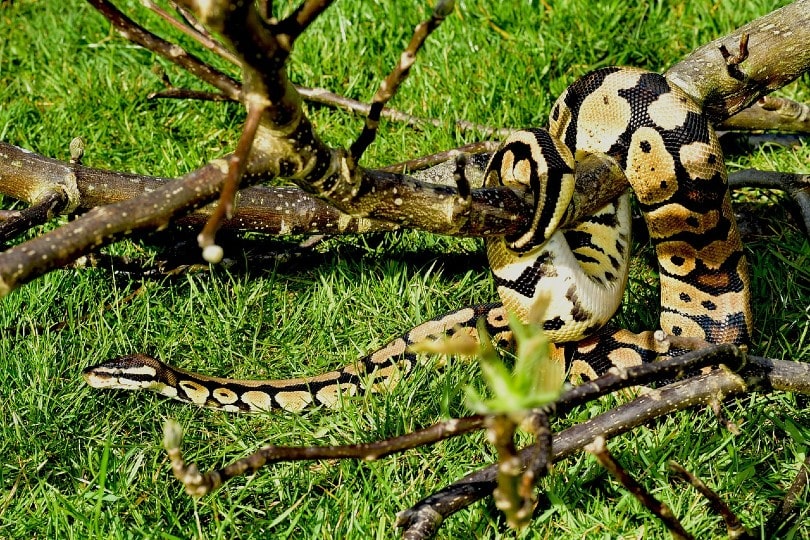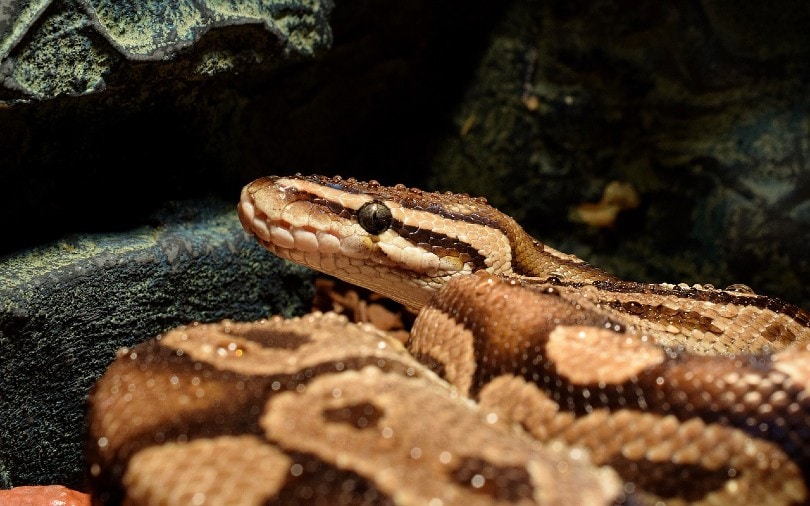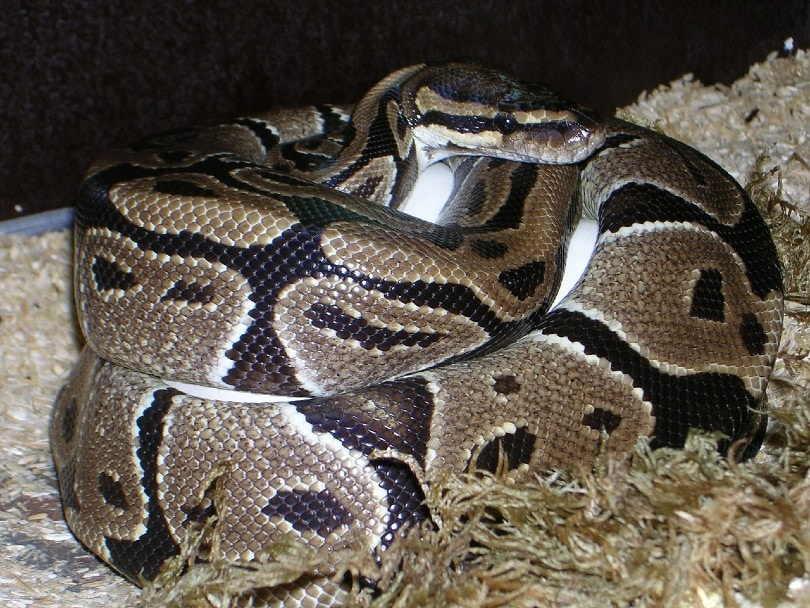VET APPROVED

The information is current and up-to-date in accordance with the latest veterinarian research.
Learn more »Click to Skip Ahead
Certain animals are social creatures that get along better if they have company, especially with the same species. That’s why it’s common to adopt two pets of the same species so that they can bond and socialize with one another.
However, does that concept hold true when it comes to ball pythons? No, ball pythons should not live together (barring a few extremely rare exceptions). In this article, we’ll go over a few things you should know about ball pythons, explain why they shouldn’t live together in the same tank, and explain the scenario in which a skilled reptile enthusiast may opt to house two ball pythons together.

Ball Pythons Living Together in the Wild
It’s important to note that ball pythons are solitary animals that prefer to be alone. While ball pythons who live in the wild do come together to breed, it’s very rare that you’ll see a group or a pair of ball pythons together.
If they have to share a burrow, it’s only because it’s absolutely necessary. Remember, just because your ball python was raised as a pet, it doesn’t change the fact that they like to be alone. This is because their instinctive desire to be solitary is hardwired into their DNA. In addition, ball pythons aren’t domesticated. As such, even pets born in an incubator would have some of the instincts of a wild ball python.


Dangers of Housing Two Ball Pythons in One Tank
You’ll be hard-pressed to find any snake expert who recommends putting two or more ball pythons in the same cage because there are dangers to doing so. In the next section, we’ll discuss a few of the dangers that you could be presented with by putting your two ball pythons in the same tank.
1. One Snake Establishing Dominance Over the Other
Since your ball python is not a social animal, it’s highly doubtful that they’re going to get along with another snake in their tank. The more dominant snake will quickly exert control and the other snake will become submissive.
This isn’t a good thing as the less strong of the two snakes will suffer because of this dominance. For example, if you see your ball pythons lying on the basking rock in the basking area together, you might think that they’re getting along and enjoying the heat.
What’s really happening is that the dominant ball python is lying on top of the submissive snake, looking to claim their resources and territory. This dominance can lead to the submissive ball python not getting the heat they need to remain healthy and can lead to additional health problems.
It’s just as important to note that not all ball pythons quickly agree to a hierarchy. In some instances, both snakes may feel compelled to exert dominance over the other, resulting in fights—which may culminate in injuries and/or stress for both individuals.

2. Issues with Feeding
The dominant ball python is likely to steal the food of the more submissive ball python as well. Lack of food will cause your more submissive snake to become sick because they’re not getting the nutrients they need to thrive.
You could, of course, feed them in separate tanks, but that comes with its own set of problems as well. Not only do you have the stress of caring for and cleaning two tanks, but you’ll also have to move the snake back to the original tank after feeding, which could cause regurgitation and health problems. Ball pythons are also more likely to strike or bite if you disturb them while they’re digesting a meal, which increases the risk of injury to you as well.
Ball pythons have also been known to starve themselves and die because they were forced to share a tank. This is certainly not what you want for your reptile pets.
3. Issues with Stress
Having another animal in their cage can cause a ball python to constantly deal with low-level stress. This can affect not only the snake’s basic bodily functions but their immune system as well.
- Refusal to eat or a lack of appetite
- Being overly active throughout the day
- Rubbing their nose against things in their tank
- Aggressive behaviors, such as striking the cage or hissing
- Behavior that they usually don’t exhibit
4. Spreading Diseases
If you have two or more ball pythons in a cage, any type of disease one snake gets can quickly spread to the other snake in the tank. One of the best ways to ensure your snake is healthy is by checking their stool periodically.
That’s becomes much more difficult if you have more than one ball python per cage because you won’t know which stool belongs to which snake.

5. Cannibalism
Although ball pythons cannibalizing one another is extremely rare, it’s happened enough times that it needs to be mentioned. This usually happens if one of the ball pythons is larger than the other. It especially happens if a ball python is left in a cage with hatchlings.
6. Unwanted Breeding
If you house a male and female ball python together (whether on purpose or inadvertently), you will almost certainly end up with eggs at some point. This isn’t as exciting as it sounds, as the logistical challenges of such a scenario are truly daunting. Unless you happen to have an incubator and around 7–10 spare enclosures (for the eventual hatchlings to be housed in), you might be setting yourself up for very unpleasant times.
It’s also important to note that housing a male and female ball python together can be extremely stressful for both individuals. The male will constantly chase and harass the female during the breeding season, even if she isn’t receptive. He may do so even to the point of starving himself and losing far too much weight (and often ending up contracting illnesses due to the weakness associated with such a metabolic state).
The female may be stressed with the constant attention of the male, and not having a safe space to which she can retreat if she wants to (as she would be in an enclosure with him). As such, she too may suffer health issues caused by the stress of mating.

Is There a Safe Way to House Two Ball Pythons in the Same Tank?
While experts agree that ball pythons should be kept in separate cages to live, there are pet owners who have put them in the same cage and had good results. While it is not recommended, it is done in some scenarios. Specifically, it is only done on a temporary basis by skilled reptile keepers who have extensive experience with breeding snakes.
As mentioned above, this practice is not without its challenges—both from a financial perspective and due to the risk of injury to both snakes involved. As such, this is a task that is best left to professionals who have the time, resources, enclosure space, and husbandry experience to successfully breed ball pythons.


Can Two Ball Pythons Live in the Same Tank?
While it is possible for two ball pythons to share the same tank during the breeding season, it’s not recommended. There’s just too much that can go wrong, and ball pythons are extremely antisocial. Putting the two snakes in the same cage can lead to diseases, stress, feeding issues, and even cannibalism.
It’s best to give each of your ball pythons the space they need to grow and thrive in a tank that is their very own for the best results. As always, if you do have questions about the health of your pet snakes, we advise following up with your exotic veterinarian for more information.
Next on your reading list:
Featured Image Credit: sipa, Pixabay










